🤓 The 2026 Local Search Ranking Factors are here!! Check out the report!
🤓 The 2026 Local Search Ranking Factors are here!! Check out the report!

A location landing page is a unique website page featuring information about a specific, physical branch of a business. Multi-location businesses create location landing pages to differentiate their premises from one another, to offer searchers a customized experience with the branch nearest them, and to increase brand visibility for localized searches.
Need to make sure customers are encountering your locations nearest them when they search? Location landing pages are the answer! When done right, location landing pages:
This is the only guide you’ll need to develop the perfect set of location landing pages for your business, whether you have just a handful of locations, or hundreds or thousands of them. We’ll equip you with a visual, keyed mockup of the 20 basic elements every location landing page should feature. Then, we’ll show you your options for additional elements that could make your location landing pages the best in town. We’ll conclude with an extremely useful location landing pages Q&A section that should answer the most common queries that may come up for you as you’re developing this powerful section of your company’s website.
💡 Pro Tip: Running a single-location business? Then your Contact Us/Visit Us page will typically be the core page for all your contact information. Too often, local business website contact pages feature nothing more than a contact form, foregoing all the conversions they can earn when properly optimized. For more on this, read: How to Create the Perfect High Converting Local Contact Us Page
The most important thing to know before you begin creating location landing pages is that they must be built for customer use. The overarching goal of investing in this form of digital publishing is to be found and chosen by customers because they encounter a location landing page that is the next best thing to a human customer service professional on your staff. Location landing pages must answer the questions customers ask and use their own common language and search language to provide those answers.
In addition to explaining “what is this business and what does it do” in clear language, Gear statements made on your location landing pages directly toward the customer. Phrase your offerings in terms of “what you’ll get” and “how you’ll benefit”, rather than “what we do.” Address the customer directly, proving how you can meet their needs.
In order to understand how to optimize your location landing pages to match customer intents and language, you can engage in the following seven forms of research:
Survey and poll communities surrounding your locations to discover how they talk about the products and services offered by your brand. Discover regional needs and linguistic differences for implementation on your relevant location landing pages.
Evaluate the top competitors in each of your markets to discover how they are wording the same goods and services you offer. This can expand your business intelligence, surfacing additional terms you may need to include in the optimization of your location landing pages.
Use keyword research tools to uncover the most popular phrasing searchers use when looking for the products and services you offer. Some useful tools to know about include question-based tools, like Answer the Public and AlsoAsked.com that provide insight into how searchers formulate questions. Note that local businesses may not be able to find accurate reporting of actual search volumes for every town and city in a country via keyword research. Consider any numbers you see as general estimates.
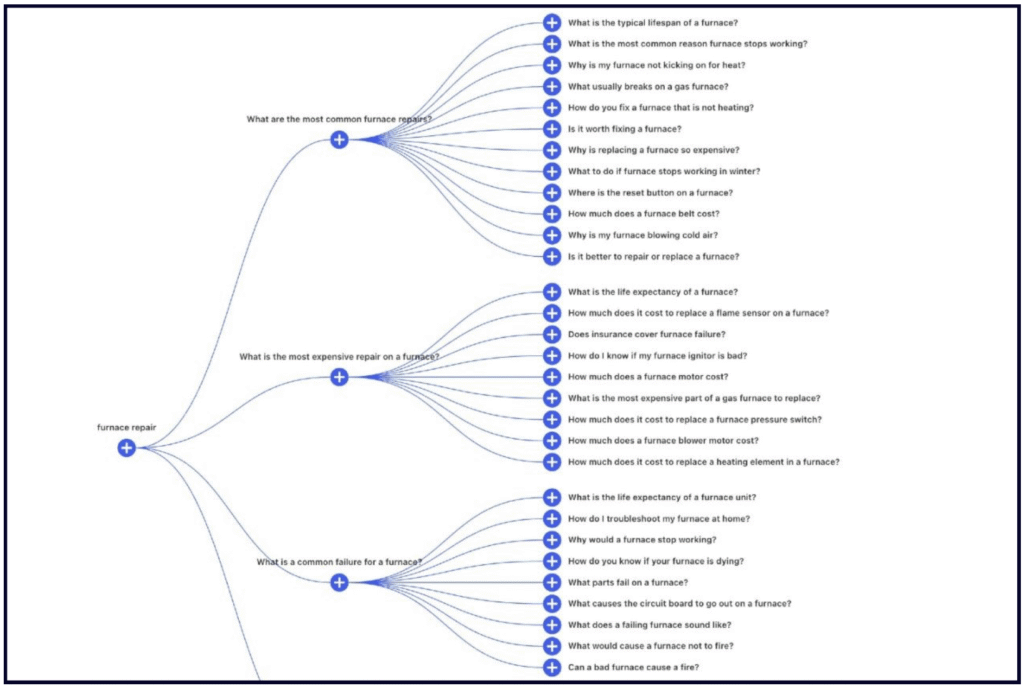
Begin typing one of your keyword phrases into Google’s search box and a dropdown will appear in which Google is autocompleting your search with suggested terminology. These auto-suggestions are based on searcher behavior, and can add to the variety of ways in which you are describing your business, your products, and your services. Additionally, many of Google’s organic search engine results include a feature called “People also ask”, which can further enhance your knowledge of how searchers are looking for what your business is and does.
Train staff to notice and document how customers are describing their needs in person, over the phone, and via text message. Come up with a list of FAQs your location landing pages can answer. Large enterprises may want to invest in call tracking technology.
Tune in to social media conversations about your industry and geographic markets. Discover what local consumers are dissatisfied with so you can offer solutions to their problems. Pay attention to discussions of competitor brands who are earning voluntary praise for getting things right; this is valuable information about what local consumers appreciate.
Make use of AI environments like ChatGPT, using prompts that generate lists of suggested keywords and questions related to your business model. As always, be wary of AI’s habit of generating nonsense. Fact-check all of its outputs to be sure they make real-world sense.
The more closely you can match customer language, the better your chances of them choosing your business after visiting one of your location landing pages. Helpfulness is the secret ingredient. And, by fulfilling the intents your research has uncovered, you’ll greatly increase your chances of search engine bots and AI scrapers making you visible as a relevant answer.
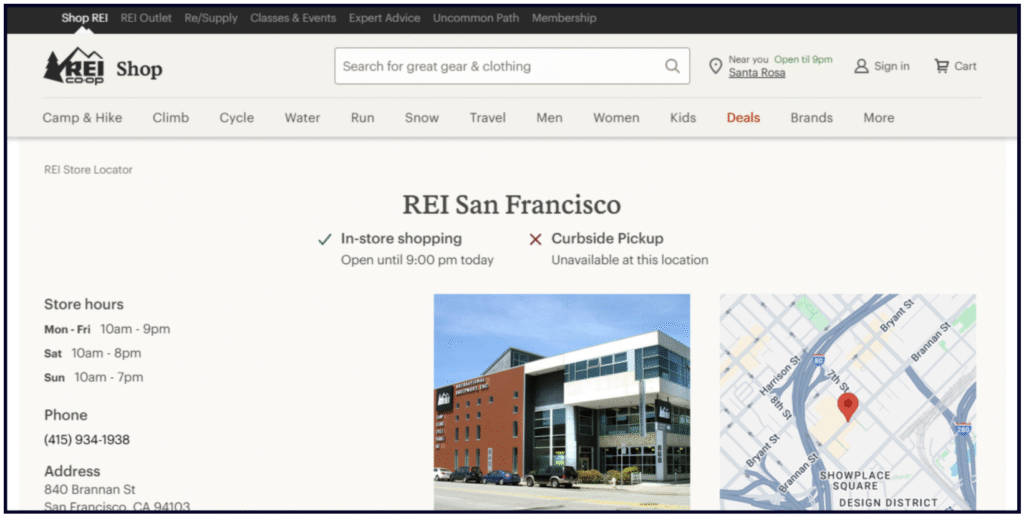
Some real-world location landing page examples you might like to look at for inspiration include those on sites like REI and Patagonia, where extra care has been taken to include features that are useful to the local public. However, the goal of this guide isn’t just to help you build good locations landing pages. We’re aiming for perfection here, so that you truly stand out in your markets!
Now that you’re in the right mindset of helping customers with your location landing pages, you’re ready to begin.
Many local business owners aren’t sure what to publish on their location landing pages, and worry that there isn’t really enough to say about each unique branch of their brand to fuel the development of truly useful content. As you’ll quickly see from this mockup and key, there is almost no end to your options.

For this exercise, we’re using a fictitious eatery called 3 Bears Breakfast Restaurant. Picture it as a popular chain with 150 locations across the US. The examples shown can be applied to nearly any multi-location local business.
Your website logo should match your real-world signage. Google can read street signage, and customers will be helped when what they see in town matches what they saw on your landing page. Branding is becoming increasingly important in the AI era, so be sure you’ve solidified how you’re representing your business, for a consistent experience across all online and offline channels.
Slogans can be an important part of building brand recognition (think of “Ace is the place with the helpful hardware folks”). If you can work top keywords into your slogan, so much the better. Above, the restaurant’s slogan mentions breakfast, which is its specialty. It is tied to the fairytale theme of the business, citing the famous element of the story in which Goldilocks tries everything in the three bears’ house until she discovers what is “just right.”

Multi-location businesses should invest in store locator widget technology to help customers find the branch nearest them. Be sure your product doesn’t confine consumers to searching by zip code only, as travelers may have no idea what zip code they are in. Locator widgets can take customers to relevant location landing pages, but there’s an important proviso here: be sure your set of location landing pages isn’t only accessible via your locator. Search engine bots and AI scrapers may not be able to access them. Either create a page on your site that lists all of your locations and links to them, or put them in a website sitemap page to ensure better crawling and scraping.
Your site’s most important pages should be consistently structured in your main navigation menu across the site. For most local businesses, the menu should include product/service pages, an about page, a reviews page, and a locations page. For multi-location businesses, the contact page should list the contact information for corporate headquarters. Individual branch contact information should be put on relevant location landing pages.
While you can move various features of your location landing pages around to emphasize whatever you think is most important to visitors, this is the one section that should always come first on the page.
Write out the complete, accurate business name as it appears in the real world and on your local business listings. Add your complete street address, your phone and text numbers, and accurate hours of operation. Include seasonal/holiday hours if applicable. Ideally, you should include an email address that goes directly to the branch for maximum accessibility, and the same applies to your social media links. If your business is operating unique social media for each distinct branch, put your linked icons here so that customers know they can reach you socially. This builds trust. Take special note of the fact that it’s vital that your contact section matches your Google Business Profiles as a signal of legitimacy.
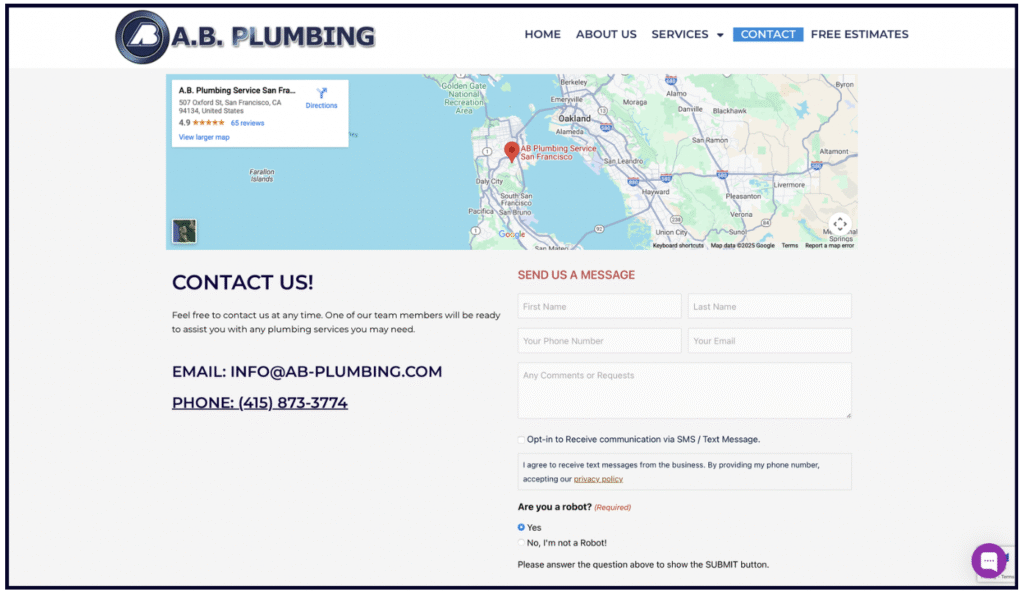
Increase user engagement with your landing pages by including at least one short video on them. The video can show your outdoor and indoor premises to help visitors find and envision your business. It can show off key inventory and amenities. It can also introduce leadership at the branch or the franchisee owner to emphasize neighborliness and expertise, with a special message about the quality of customer service a community can experience when they come in.
Write original text that succinctly describes how the customer will benefit from patronizing the business. An example for our fictitious restaurant might be “Start your day right at Treegrove’s coziest breakfast restaurant.” Write a description of the key features of the business that your research has indicated are in local demand. This is a great place to use your keyword research.
Embed a Google Map so that customers can click around to easily find your location from wherever they are setting out. Be sure you are embedding a map that features your business location – not just a generic map of the address.
Offer a detailed explanation of how to get to you from main points around town. Keep travelers and new neighbors in mind who aren’t already familiar with your city’s layout when writing directions. It can be helpful to tie your location to something very visible in the landscape like “we are across the street from the Treegrove Museum.” You can also maximize the usefulness of this section by adding walking directions and public transportation links.
Like the video section, this is an opportunity to customize each landing page with lots of distinctive imagery. Showcase premises, amenities, products, services, and staff. Photography is one of the most important investments of time/money you can make in your local business. Whether you hire a professional photographer or just use your mobile phone, custom images confirm the legitimacy of your business location, give website reason to spend time on your page (a user behavior signal), and can be brought up by Google in answer to a variety of searches. For more on this, read 10 Expert Tips for Taking Great Photos for your Google Business Profile.

At minimum, your landing page should list out and link to the key products and services offered at the location. To go one better, read on to the Advanced Location Landing Page Elements section of this guide. The more confident a customer is that you stock or offer what they need, the better your chances of converting them.
Put extra care into this section that highlights special features of the business location that could match a specific customer intent. Your Google Business Profiles contain a section called “Attributes” that looks like this in your New Merchant Experience dashboard and which can give you some amenity ideas:
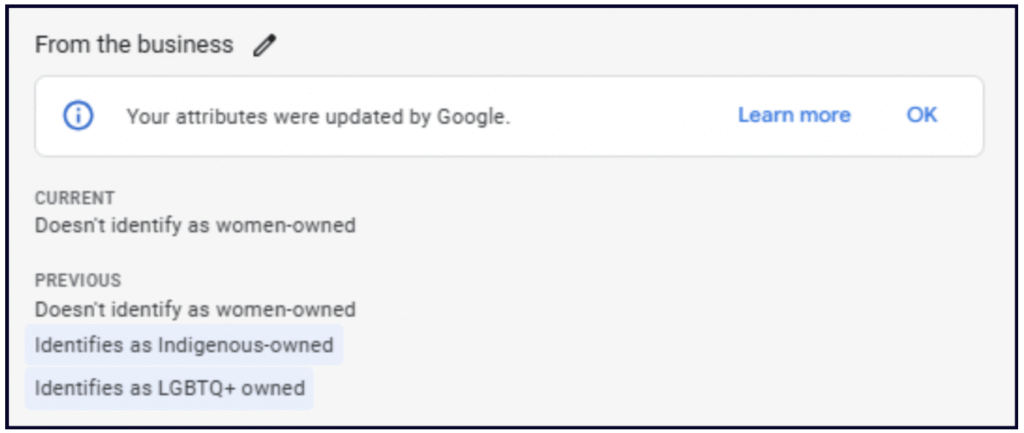
Amenities to consider listing if they are applicable to your business include:
Having this type of language on the page can help both search engines and people understand that you meet refined intents. Content of this kind is becoming more important due to the rise fo conversational AI. As people get used to using conversational queries instead of keyword search, they tend to get more granular about what they’re looking for. An example of a conversational query is, “Please give me a list of cafes in Seattle that are wheelchair accessible, LGBTQ friendly, and have free WiFi” vs. a more traditional keyword search like “wheelchair accessible cafe Seatte”. Don’t miss on adding these details to your location pages, and don’t be shy about getting very detailed. The more details you can associate with your locations, the better.
This section offers one of the best opportunities for differentiating your landing pages from one another. You can embed third-party reviews as well as publishing first-party reviews and testimonials you have collected directly from your own customers for the location. Be sure you are not cherry-picking third-party review content to show only positive sentiment, as this is a dishonest business practice. Don’t overlook the value of showcasing photos or scans of hand-written customer testimonials. They have the ring of authenticity and can help potential customers trust that your business will take good care of them.
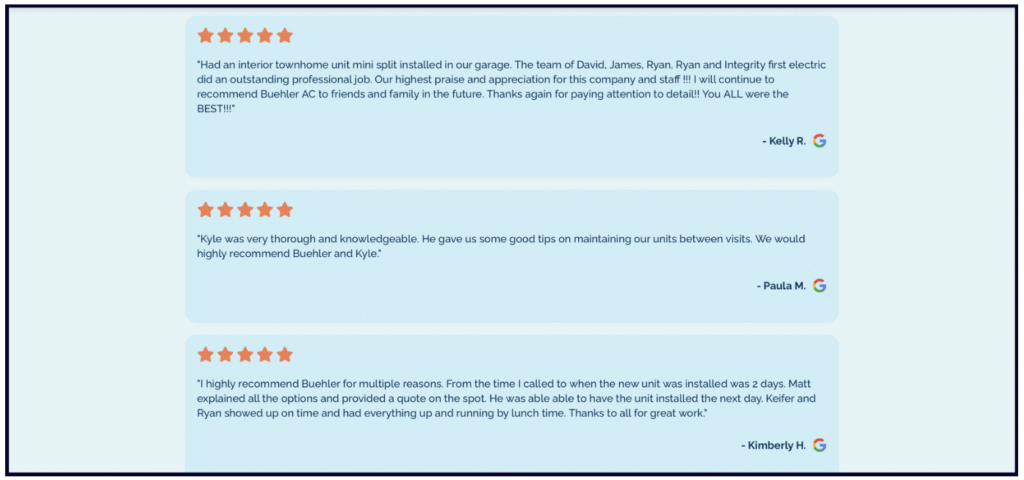
Use icons to make it possible for customers to easily get from the landing page to the review profiles associated with the location so that they can leave a review. Just be sure you are not offering any incentives in exchange for reviews, as this is a violation of most review platform guidelines as well as the laws of many nations.
Increase customer trust by creating a generous satisfaction guarantee policy and posting it to the page. Tell customers what they have the right to expect and what promises your staff will stand by at the location. This is also a very good place to urge customers who have had a dissatisfactory experience to contact a specific person at the branch who can make it right. This offer can reduce the number of negative reviews the business receives because customers understand that their complaints will be heard and resolved by real people at the location.
Detail ways in which the business is a good choice because of its contributions to the community. This could include:
The more involved each branch is in its local community, the better story it will have to tell about why customers can feel good about supporting it.

Be sure to draw attention to any awards for excellence that the branch has received as well as any local or industry associations it has developed. These can be competitive difference makers in the eyes of consumers.
If the business has published or been featured in blog posts, podcast episodes, or video media related to the specific branch, include it here. A multimedia presence affirms the legitimacy of a brand, and shows that it is actively outreaching to the public with its expertise.
Sales, deals, coupons, discount codes, event calendars, and other special offers can provide an extra incentive for customers to choose the business.
Never close any page on your website without at least one call-to-action. Calls-to-action assist the visitor in taking the next step they want to take as well as highlighting the next step the business wants them to take. CTAs could include booking functionality to schedule an appointment, filling out a form, calling the business, texting the business, and, of course, visiting the business in person.

💡 Pro Tip: Don’t make the mistake of putting in the work to create amazing content for your location landing pages and then publishing it in such a way that Google can’t crawl it!
Just recently, we saw an example in which a multi-location business had incorporated many of the above elements, but the content was loaded into the page post-loading via JavaScript, making it basically invisible to crawlers. Meanwhile, the page lacked other on-page SEO basics like an optimized title tag, header tags, and optimized text content. The title tags were not optimized at all, no H1s, and basically no content.
Good location landing pages must incorporate standard SEO and technical best practices to ensure they can be crawled, understood, and indexed by search engines and AI scrapers for display in their results.
With just these 20 sections, each branch of your multi-location enterprise will be very strong because of their usefulness to the public. But there’s still more you can do to take your landing pages to the next level.
Publish the strongest location landing pages in your markets with these additional features:
If the website is e-commerce-enabled, landing pages can link to filtered inventory that guarantees that a particular product is available at a nearby location. If a product is not available at the branch closest to the customer, they should be shown the next-nearest branch that has it in stock.
Text-based reviews are a great start, but you can go one further by filming video shorts of the location’s happiest and most loyal customers explaining why they’ve come to count on the local branch of the brand.
Showcase the authority present at the location by offering expert advice to the local community. This could include an explanation of applicable laws and regulations, how-to content related to the products being sold, budgeting tips, care and maintenance advice, or anything that proves that the branch is being operated by true experts in its field.
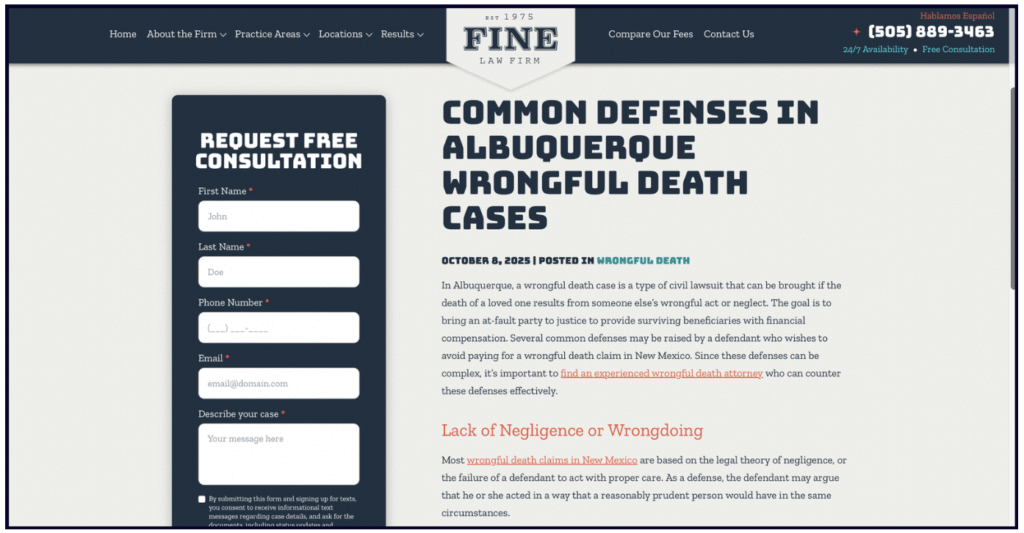
Make use of the research the business has conducted to identify questions the staff field repeatedly, and to offer authoritative answers.
Increase customer retention by incentivizing repeat visits and referrals with rewards.
Use the landing page to encourage customers to sign up with their email or text number to receive benefits like a newsletter, special offers, or other goods. This will help your branches build a marketing channel that is outside the control of any third-party platform.
Location landing pages can be a gateway to app signups. They can also feature useful tools, such as calculators, forecasts, virtual reality products, etc.
When staffed by humans, live chat options can help potential customers in a hurry to get a quick answer to what they need in order to choose the business. Be wary of chatbots, however, if they don’t provide an excellent degree of customer satisfaction, and if AI is used, be aware that its hallucinations could become a source of brand liability.

With so many communities having now lost their local newspapers, brands can consider filling some of the gap with relevant local news stories, if the resources are available to research and publish current information.
Location landing pages can be a good entry point to branch-specific job postings, offering local employment opportunities in your communities.
There are multiple areas of location landing pages that can benefit from the use of Schema markup, which can make the contents of a complex page more intelligible to search engine bots and, possibly, AI scrapers. Google offers its own guide to correct local business Schema implementation, and Whitespark has expert commentary on how local brands are making use of this form of markup today.
Create bios of public-facing staff at locations for a friendly and relatable welcome. Add product recommendations from staff members (like bookstore employees picking their favorite books). Let staff tell their own story about how the business serves the community.
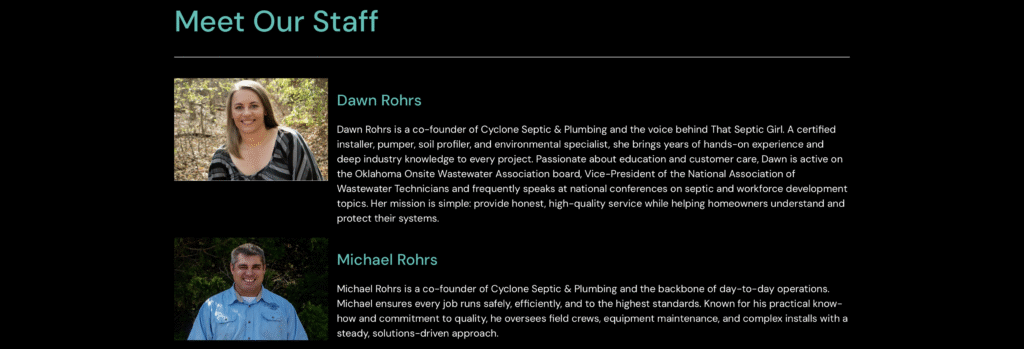
Include information that showcases your expertise about the locations you serve. For example, a brand that provides at-home assistance could create a section on nearby memory cafes or dementia-friendly public transport. A native plant nursery could create a guide to where to spot local wildflowers around the community in spring.
Create a section on the page featuring links to a couple of alternate nearby locations of the brand. This can help potential customers plan trips to the business and it’s also a wonderful way to build additional internal links to location pages which are typically starved for internal links. This will help the crawlers flow through multiple locations and pass more authority signals through these pages.
You’ve now reviewed over 30 different possible elements your location landing pages could feature, and even reading through this list may have sparked fresh ideas beyond what’s been covered. However, it’s likely that you have some key questions before you start publishing. Whitespark is ready to answer them!
Q: Do I need to be worried about duplicate content across my location landing pages?
A: Almost never. You may have heard rumors about something called a “duplicate content penalty” being issued by Google if multiple pages on your website feature similar content. This is a misunderstanding that has existed for years. Duplicate content penalties are extremely rare and Google only applies them if your website is scraping and plagiarizing the content of a third party. Please, don’t be concerned that more than one page on your company’s own website is listing a similar product/service menu, answering similar FAQs, or features similar CTA. It’s nothing to worry about.
Q: Do I need to be worried if my brand is publishing large volumes of thin content in the form of location landing pages?
A: Yes, you might have some cause for concern here. If your brand takes a shortcut and publishes a large volume of thin content pages of any kind, instead of publishing content that is useful to human visitors, it can earn a reputation with Google as a low-quality site. Both page level and site-wide quality signals impact your visibility in search engine results. Unhelpful pages also miss the opportunity to assist customers on their journey to your doors. Best practice here is that, if your brand isn’t ready to make a serious investment in strong location landing pages, wait until you are before you publish them.
Q: Should I build location landing pages for cities where I lack physical premises?
A: You should never misrepresent your business locations to the public or to platforms like Google. This can only have a negative effect on your brand’s reputation because you are misleading and inconveniencing the public. There are other forms of landing pages that are sometimes appropriate to develop. For example, a hybrid business that has in-house dining and home delivery might develop a set of service area landing pages to represent the extent of its delivery radius, but this is a separate topic. A location landing page should always represent a real-world location that is accessible to consumers.
Q: Should I link my Google Business Profiles to their respective location landing pages or to my website’s homepage?
A: It has always provided a far better user experience to link from your GBP’s URL field to the landing page of the location it represents. In other words, customer convenience is prioritized when your GBP for your Denver location links to your Denver landing page, and your Des Moines GBP links to your Des Moines landing page, rather than to your homepage. If searchers are taken to a homepage, it’s an extra and unnecessary hassle for them to then try to relocate information about the branch nearest them. Removing friction is always a positive move!
However, this FAQ has arisen from the fact that website homepages have typically amassed more ranking authority than an individual location landing page on the site. At times, some marketers have suggested linking all GBPs to company homepages because it could often create a local ranking boost. This created a dynamic in which brands had to choose whether to prioritize discoverability over customer care – not a great choice to have to make.
It’s important to know that recent developments have altered this conversation. In particular, a 2024 update to Google’s algorithm by which it ranks its results is impacting marketing best practices. This update is informally known as the “diversity update” because it appears to have the goal of diversifying Google’s search engine results so that the businesses ranking highly in Google’s local packs are not also being featured at the top of the organic rankings. Sterling Sky has published the best coverage of this update, and their current stance is that your GBPs should no longer link to your company’s homepage if you wish to avoid organic results demotion. This comes as good news to brands who have always prioritized consumer convenience over ranking tactics.
Q: How should I prioritize the content on my location landing pages?
A: The answer to this will be unique to each company. Without exception, your complete contact information should be the first thing on each page. But after that, you should prioritize the elements that you believe are the most helpful to customers trying to decide whether to choose your brand for a transaction. It’s always a best practice to try to summarize key benefits near the tops of pages for customers in a hurry. You can then move on to deeper dives into the finer details of your business for visitors in research mode. While our mockup provides a location landing page template, please feel free to customize it to best meet the needs of each of the communities you serve.
Q: Is there anything I should avoid in my location landing pages?
A: Whitespark encourages you to approach the creation of this valuable set of pages on your website with creativity and vigor. There are, however, a few things you should avoid:
Q: How should I handle location landing page management in chain and franchise scenarios?
A: The people on the ground at your various branches have the most hyperlocal expertise to bring to the marketing of their premises. Where possible, invest in a content management system (CMS) with sophisticated access permissions that enable branch managers or franchisees to access and update appropriate pages on the site. This can go far towards customizing and localizing the content of each location landing page. However, before you hand over the keys, be sure all contributors have been trained in brand standards, voice, protocols, and guidelines so that they are perfectly equipped to represent the business well.
Location landing pages are just one area of your website that can bring customers to your doors. Brands that think holistically about how their entire site can work as a customer service asset are real winners. Read the Whitespark Guide to the Perfect Small Local Business Website.
Miriam Ellis is a local SEO columnist and consultant. She has been cited as one of the top five most prolific women writers in the SEO industry. Miriam is also an award-winning fine artist and her work can be seen at MiriamEllis.com.
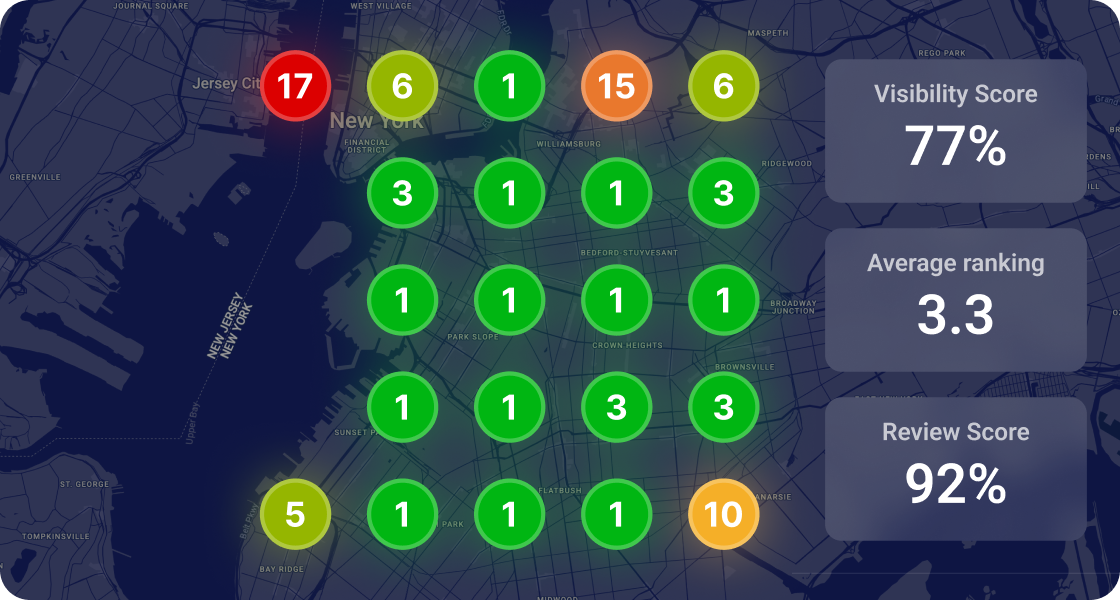

Whitespark provides powerful software and expert services to help businesses and agencies drive more leads through local search.
Founded in 2005 in Edmonton, Alberta, Canada, we initially offered web design and SEO services to local businesses. While we still work closely with many clients locally, we have successfully grown over the past 20 years to support over 100,000 enterprises, agencies, and small businesses globally with our cutting-edge software and services.